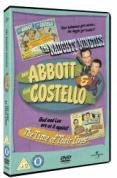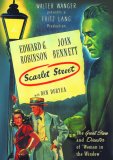 Abbott And Costello - The Collection | DVD | (28/08/2006)
from £39.99
| Saving you £-19.99 (N/A%)
| RRP
Abbott And Costello - The Collection | DVD | (28/08/2006)
from £39.99
| Saving you £-19.99 (N/A%)
| RRP *Titles to be confirmed
 Naughty Nineties / The Time Of Their Lives | DVD | (28/08/2006)
from £20.00
| Saving you £-10.01 (N/A%)
| RRP
Naughty Nineties / The Time Of Their Lives | DVD | (28/08/2006)
from £20.00
| Saving you £-10.01 (N/A%)
| RRP The Naughty Nineties: Set aboard the River Queen showboat Bud and Lou perform their legendary ""Who's on First?"" routine. The Time Of Their Lives: Two ghosts who were mistakenly branded as traitors during the Revolutionary War return to 20th century New England to retieve a letter from George Washington which would prove their innocence.
![Cover Girl [1944]](/pictures/1012345.jpg) Cover Girl | DVD | (18/08/2003)
from £14.29
| Saving you £-4.30 (N/A%)
| RRP
Cover Girl | DVD | (18/08/2003)
from £14.29
| Saving you £-4.30 (N/A%)
| RRP Cover Girl was one of the big hits of Rita Hayworth's run as movie queen (and World War II pinup girl), a splashy musical geared to the talents of its redheaded star. Be warned: this is the kind of movie in which a single magazine cover turns an unknown dancer into the toast of her own Broadway show, virtually overnight. The corn runs high, but so do the spirits; plus, Eve Arden is around to toss in her trademark one-liners. Gene Kelly, as Hayworth's sulky choreographer and part-time boyfriend, stops the movie cold with his brilliant dance alongside his own reflection. The Jerome Kern-Ira Gershwin songs are middling, except for the lovely "Long Ago and Far Away". One number presents a parade of magazine cover girls come to life (great snapshot of an era). And check out the movie's hats: a parade of insane creations, perched uncertainly on many beautiful women's heads. --Robert Horton
 Scarlet Street | DVD | (06/11/2006)
from £15.13
| Saving you £-10.14 (N/A%)
| RRP
Scarlet Street | DVD | (06/11/2006)
from £15.13
| Saving you £-10.14 (N/A%)
| RRP ![Scarlet Street [1946]](/pictures/1012866.jpg) Scarlet Street | DVD | (18/03/2002)
from £14.98
| Saving you £1.01 (6.74%)
| RRP
Scarlet Street | DVD | (18/03/2002)
from £14.98
| Saving you £1.01 (6.74%)
| RRP In a way, Scarlet Street is a remake. It's taken from a French novel, La Chienne (literally, "The Bitch") that was first filmed by Jean Renoir in 1931. Renoir brought to the sordid tale all the colour and vitality of Montmartre; Fritz Lang's version shows us a far harsher and bleaker world. The film replays the triangle set-up from Lang's previous picture, The Woman in the Window, with the same three actors. Once again, Edward G Robinson plays a respectable middle-aged citizen snared by the charms of Joan Bennett's streetwalker, with Dan Duryea as her low-life pimp. But this time around, all three characters have moved several notches down the ethical scale. Robinson, who in the earlier film played a college professor who kills by accident, here becomes a downtrodden clerk with a nagging, shrewish wife and unfilled ambitions as an artist, a man who murders in a jealous rage. Bennett is a mercenary vamp, none too bright, and Duryea brutal and heartless. The plot closes around the three of them like a steel trap. This is Lang at his most dispassionate. Scarlet Street is a tour de force of noir filmmaking, brilliant but ice-cold. When it was made the film hit censorship problems, since at the time it was unacceptable to show a murder going unpunished. Lang went out of his way to show the killer plunged into the mental hell of his own guilt, but for some authorities this still wasn't enough, and the film was banned in New York State for being "immoral, indecent and corrupt". Not that this did its box-office returns any harm at all. On the DVD: sparse pickings. There's an interactive menu that zips past too fast to be of much use. The full-length commentary by Russell Cawthorne adds the occasional insight, but it's repetitive and not always reliable. (He gets actors' names wrong, for a start.) The box claims the print's been "fully restored and digitally remastered", but you'd never guess. --Philip Kemp
![WOMAN IN BLACK (BLU RAY) - PLAY, THE [Blu-ray]](/pictures/1141068.jpg) WOMAN IN BLACK (BLU RAY) - PLAY, THE | Blu Ray | (18/06/2012)
from £16.40
| Saving you £N/A (N/A%)
| RRP
WOMAN IN BLACK (BLU RAY) - PLAY, THE | Blu Ray | (18/06/2012)
from £16.40
| Saving you £N/A (N/A%)
| RRP Based on the classic ghost story, The Woman In Black tells the tale of Arthur Kipps (Daniel Radcliffe), a lawyer who is forced to leave his young son and travel to a remote village to attend to the affairs of the recently deceased owner of Eel Marsh House. Working alone in the old mansion, Kipps begins to uncover the town's tragic and tortured secrets and his fears escalate when he discovers that local children have been disappearing under mysterious circumstances. When those closest.
![Scarlet Street [1946]](/pictures/1012149.jpg) Scarlet Street | DVD | (17/11/2003)
from £11.80
| Saving you £-6.81 (N/A%)
| RRP
Scarlet Street | DVD | (17/11/2003)
from £11.80
| Saving you £-6.81 (N/A%)
| RRP In a way, Scarlet Street is a remake. It's taken from a French novel, La Chienne (literally, "The Bitch") that was first filmed by Jean Renoir in 1931. Renoir brought to the sordid tale all the colour and vitality of Montmartre; Fritz Lang's version shows us a far harsher and bleaker world. The film replays the triangle set-up from Lang's previous picture, The Woman in the Window, with the same three actors. Once again, Edward G Robinson plays a respectable middle-aged citizen snared by the charms of Joan Bennett's streetwalker, with Dan Duryea as her low-life pimp. But this time around, all three characters have moved several notches down the ethical scale. Robinson, who in the earlier film played a college professor who kills by accident, here becomes a downtrodden clerk with a nagging, shrewish wife and unfilled ambitions as an artist, a man who murders in a jealous rage. Bennett is a mercenary vamp, none too bright, and Duryea brutal and heartless. The plot closes around the three of them like a steel trap. This is Lang at his most dispassionate. Scarlet Street is a tour de force of noir filmmaking, brilliant but ice-cold. When it was made the film hit censorship problems, since at the time it was unacceptable to show a murder going unpunished. Lang went out of his way to show the killer plunged into the mental hell of his own guilt, but for some authorities this still wasn't enough, and the film was banned in New York State for being "immoral, indecent and corrupt". Not that this did its box-office returns any harm at all. On the DVD: sparse pickings. There's an interactive menu that zips past too fast to be of much use. The full-length commentary by Russell Cawthorne adds the occasional insight, but it's repetitive and not always reliable. (He gets actors' names wrong, for a start.) The box claims the print's been "fully restored and digitally remastered", but you'd never guess. --Philip Kemp

Please wait. Loading...
This site uses cookies.
More details in our privacy policy